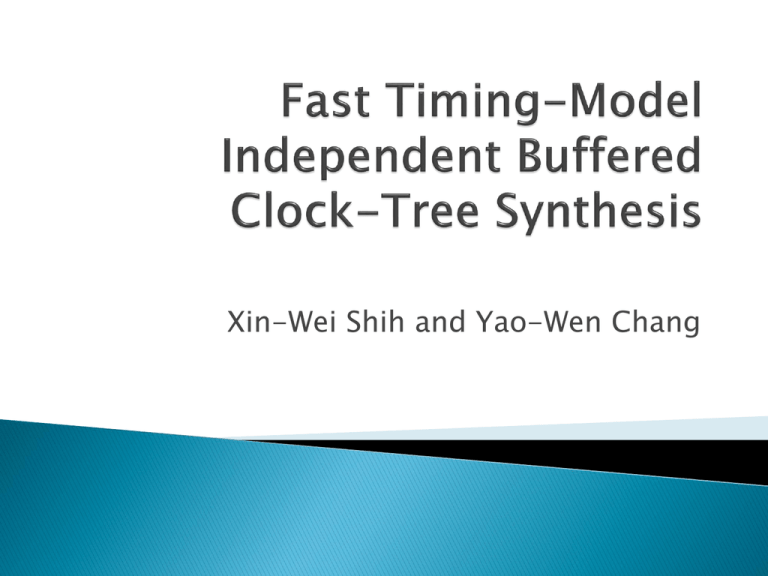Fast Timing-Model Independent Buffered Clock
advertisement

Xin-Wei Shih and Yao-Wen Chang Introduction Problem formulation Algorithms Experimental results Conclusions Skew-minimized buffered clock-tree synthesis plays an important role in highperformance VLSI designs for synchronous circuits. Due to the insufficient accuracy of existing timing models for modern chip design, embedding simulation process into a clocktree synthesis flow becomes inevitable. A possible way to improve the speed is performing the clock construction by structure optimization. ◦ Mesh In this paper, a novel timing-model independent buffered clock tree synthesis method is proposed. ◦ Buffering and wiring structures of all paths from the clock source to its sinks are almost the same. Problem: Buffered Clock-Tree Synthesis (BCTS) Instance: Given a set of clock sinks, a slewrate constraint, and a library of buffers. Question: Construct a buffered clock tree to minimize its skew, subject to no slew-rate violation. The number of leaves (sinks) can be treated as a multiplication sequence of branching. ◦ This multiplication sequence exactly forms a factorization. Then, the BNP is arranged in the nonincreasing order1 of the factorization list. A top-down manner like [10] or a bottom-up one like [7, 11], they can hardly apply to non binary tree structures. Therefore, we propose a novel partitioning method, which can not only handle nonbinary tree structures, but also achieve good quality in terms of the cluster diameter. ◦ cluster diameter : the maximum distance among sub-trees within the same cluster. We borrow the idea of cake cutting, i.e., slicing a cake into pieces from the center of the cake. Since the identical branch numbers at the same level are required in the symmetrical structure, a pseudo sink should be transformed into a dangling wire to maintain the symmetry. For partitioning, we relax that the sizes of clusters in a partition can differ by at most one for the first recursion. For node embedding, we let the embedding regions of pseudo sinks cover the entire chip. A top-down manner ◦ By tracing along the tree edges, once the slew rate is about to violate the constraint, identical buffers are inserted for all branches. ◦ Insert identical buffers in terms of the type and the size at the same level. ◦ The slew rate is approximated by accumulated capacitance starting from the latest inserted buffer. Implemented in the C++ programming language on a 2.6 GHz AMD-64 workstation. Four ISPD’09 Clock Network Synthesis Contest benchmarks with no blockages [17] and the IBM benchmarks [19]. Use ngspice [13] simulation based on the 45nm process technology [14] to evaluate the quality. clock skew (skew) clock-latency range(CLR) total resource usage (usage) We have presented a fast timing-model independent buffered clock tree synthesis method to construct a symmetrical clock tree with little wiring overhead. By symmetrically constructing a clock tree, the clock skew can be minimized without referring to simulation information.











